Toyota has honoured its commitment to produce an exciting new affordable sportscar by announcing a starting price of just $29,990 for the ground-breaking 86 coupe at its official Australian launch today.
As expected, the 86 arrives in two specification grades, with both the sub-$30,000 entry-level GT variant and the flagship GTS ($35,490) coming as standard with a six-speed manual transmission, while a six-speed automatic transmission, optional for both models, adds $2500 to the price.
That makes the 2+2-seater 86 more accessible than established small sports hatchbacks like Volkswagen’s Golf GTI hatchbacks (priced from $38,990), the Mazda3 MPS hatch ($39,490), Subaru’s Impreza WRX hatch and sedan ($39,990), the Renault Megane RS250 coupe ($41,990) and Mitsubishi’s Lancer Ralliart hatch and sedan ($44,490).
That group will be joined by Ford’s new Focus ST here by year’s end, but in contrast to these front-wheel drive models (and the WRX and Ralliart all-wheel drives), the 86 also brings rear-wheel drive to the affordable sportscar arena. Mazda’s evergreen MX-5 roadster ($44,265, or $47,200 in folding hard-top form) was previously Australia’s cheapest rear-drive sportscar.
While the 86 GT manual costs fully $5000 less than Honda’s CR-Z hybrid manual coupe (from $34,990), it's still a $6000 premium above the less powerful - but similarly dynamic - Hyundai Veloster (from $23,990) and a higher price disparity still, against another front-drive compact from Korea, the Kia Cerato Koup, which remains Australia’s cheapest sporting model from just $23,390.
Instead, the 86 will compete with Hyundai’s upcoming Veloster Turbo, while the top-shelf 86 GTS will provide stiff competition for front-drive European two-doors such as the Mini Cooper S Coupe ($42,990) and VW’s Scirocco R Coupe ($47,490).
The 86’s closely guarded starting price has been the subject of speculation ever since Toyota and Subaru announced it would co-develop an affordable, compact rear-drive coupe – based on the new Impreza platform and powered by a 2.0-litre Subaru flat-four with Toyota D-4S direct-injection - more than four years ago.
Up until now, it was one of the few things unknown about the compact 86 four-seater – the first sportscar available from Toyota in six years – which is already a sell-out success in Australia, where more than 400 pre-orders have exhausted the initial supply of one or two examples for each dealership, leading to waiting times of at least two months.
Australian dealers began taking $1000 deposits for the first Toyota sportscar since the Celica – and the first rear-drive Toyota passenger car since the MR2, which was also discontinued here in 2006 – since December, and some prospective buyers have offered up to $3000 extra to jump the delivery cue.
As Toyota points out, the result is the world’s only front-mounted boxer engine driving the rear wheels and a return to the popular compact rear-drive formula employed most famously by Toyota in the Corolla AE86 of the mid-1980s.
Of course Porsche’s Boxster roadster and closely related Cayman coupe – against which the 86 was ambitiously benchmarked – also drive their rear wheels with boxer engines, but they are mid-engined, while the iconic 911 is rear-engined.
Subaru’s near-identical model, the BRZ, is not due on sale here until August, and Toyota has all but confirmed it will also produce a convertible version of the 86, which is known as the GT in Europe and the Scion FR-S in the US.
Like the BRZ, whose engine cover also bears both the Toyota and Subaru names, the 86 is powered by a horizontally opposed 16-valve DOHC four-cylinder petrol engine that displaces 1998cc via square bore and stroke dimensions of, yes, 86mm.
Running on 98 RON premium unleaded with a high 12.5:1 compression ratio and fitted with Toyota’s D-4S dual direct-injection system, the 86 produces a relatively high 147kW at a heady 7000rpm and a modest 205Nm of torque between an equally revvy 6400 and 6600rpm.
Maximum engine speed is a feisty 7450pm and, in another new benchmark for Toyota’s first mass-production four-cylinder boxer, a specific output of 100hp per litre.
Both the GT and GTS come with a 50-litre fuel tank and a relatively short 4.1:1 final drive, but both six-speed automatic versions – which come with taller internal gear ratios than the six-speed manual across the board, as well as steering wheel paddle shifters for the GTS and a throttle-blip function during downshifts – are more efficient.
The conventional automatic, which Toyota says was inspired by the Lexus IS-F and can shift gears in just 0.2 seconds, returns combined fuel consumption of 7.1 litres per 100km and emits 164 grams of CO2 per kilometre, while the manual consumes 7.8L/100km and emits 181g/km.
Toyota has issued performance figures for the 86, the manual version of which is claimed to sprint to 100km/h in 7.6 seconds on its way to a 226km/h top speed. The auto is slower on both counts, at 8.2 seconds and 210km/h.
Not content with modelling its chassis powertrain format on one of the world’s finest sportscar’s, Toyota says the 86’s 460mm centre of gravity is in fact some 18mm lower than the Cayman’s. Its kerb weight is also at least 100kg lower at 1222kg, resulting in an enviable power-to-weight ratio of 120kW/tonne.
The 86 also features the lowest driver hip-point of any Toyota production vehicle at 400mm, and its engine – which drives through a Torsen limited-slip differential in all but the GT auto variant - is mounted as low and far back as possible, resulting in 53/47 front/rear weight distribution.
In another break with tradition, the boxer engine’s sound is channelled directly into the cabin via a sound generator – the first system of its type to be used in a Toyota.
Despite its relatively low pricetag, both versions of the 86 come with a generous armoury of standard equipment, with safety gear including seven airbags, a five-mode electronic stability control system (VSC), traction control (TCS) and an anti-lock braking system (ABS) with electronic brake-force distribution (EBD) and brake assist (BA).
The base 86 rides on 16x6.5-inch alloy wheels with relatively narrow 205/55-section tyres (and a full-size spare – steel in the GT’s case), and comes with cruise control, air-conditioning and a CD sound system with Bluetooth, voice recognition and USB/AUX inputs.
Also standard across the range are halogen headlights, daytime running lamps, a multi-information display, power windows/mirrors, a rear foglight, tilt and telescopic steering wheel adjustment, a folding rear seatback, analogue speedo, ‘premium’ three-spoke steering wheel, shift lever and shift knob, and a urethane-covered parking brake lever.
The top-shelf 86 GTS adds 17x7.0-inch alloys with 215/45 tyres, steering wheel paddle shifters (auto only), a 6.1-inch colour touch-screen and satellite-navigation with live traffic updates, 3D map display, RDS-TMC (SUNA) traffic information, speed camera warnings, SMS and email text to voice, FM radio text and SD card slot.
Buyers of the premium GTS also score auto-leveling high intensity discharge (HID) headlights, LED DRLs, front foglights, keyless entry/starting, a digital speedo, dual-zone climate-control, leather-accented Alcantara-trimmed front seats with heating, aluminium pedals and door sills, a ‘premium’ three-spoke steering wheel and park brake lever, ‘carbon-look’ instrument panel, a world-first frameless interior rear-view mirror and red stitching interior highlights.
Overall, the 86 measures 4240mm long, 1775mm wide and a low 1285mm high, making it 5mm shorter than a Corolla hatchback and some 225mm lower than a three-door Yaris hatch. Wheelbase is also shorter than the Corolla’s, 2570mm, while wheel tracks are a broad 1520 front and 1540mm rear.
The four-seat 86 offers 1065mm of front legroom but just 759mm for rear passengers, along with an 11.4-metre turning circle via its electrically assisted rack-and-pinion steering system with a quick 13.1:1 steering ratio.
Braking for the entry-level 86 is via 277x24mm ventilated front discs and 286x10mm rear rotors, while the GTS gains larger 294mm front discs and larger and thicker 290x18mm rear discs. The handbrake is a lightweight lever (not electric) type, which is perfect for handbrake turns.
The sleek two-door body, which has a drag co-efficient of just 0.27Cd, is suspended by MacPherson struts up front and double-wishbones at the rear, both supported by coil springs, gas dampers and rose-jointed anti-roll bars.
Toyota says the 86, various concepts of which have appeared in recent years, borrows a number of key design elements from the 2000GT coupe – which was co-developed by Toyota and Yamaha - including its long bonnet, side window shape and rear bumper line.
A range of unique styling cues highlight both the car’s name and its maker, including a subtle T-mesh (for Toyota) pattern for the front grille, door-switch base, instrument panel, meters, triangular central rear foglight and spare-wheel cover, and a conrod motif for the headlights, twin exhausts, instrument dials, air-vents and gear-lever base.
Designed to reflect the car’s unique front boxer engine, rear-drive layout – as well as the vehicle’s tyres sliding in a four-wheel drift – is an 86 boxer piston logo on the car’s front wing, with red highlights for the GTS.
Like all new Toyota vehicles, the 86 is covered by a capped-price servicing plan, with up to four scheduled services, each priced at $170.
Australia’s 86 – which is known as the GT 86 in Europe and the Scion FR-S in the US - will be available in seven exterior paint colours: Pegasus White, Tornado Grey, Mount Fuji Red, Sonic Blue, Thunder Silver, Storm Black and Velocity Orange.
As expected, the 86 arrives in two specification grades, with both the sub-$30,000 entry-level GT variant and the flagship GTS ($35,490) coming as standard with a six-speed manual transmission, while a six-speed automatic transmission, optional for both models, adds $2500 to the price.
That makes the 2+2-seater 86 more accessible than established small sports hatchbacks like Volkswagen’s Golf GTI hatchbacks (priced from $38,990), the Mazda3 MPS hatch ($39,490), Subaru’s Impreza WRX hatch and sedan ($39,990), the Renault Megane RS250 coupe ($41,990) and Mitsubishi’s Lancer Ralliart hatch and sedan ($44,490).
That group will be joined by Ford’s new Focus ST here by year’s end, but in contrast to these front-wheel drive models (and the WRX and Ralliart all-wheel drives), the 86 also brings rear-wheel drive to the affordable sportscar arena. Mazda’s evergreen MX-5 roadster ($44,265, or $47,200 in folding hard-top form) was previously Australia’s cheapest rear-drive sportscar.
While the 86 GT manual costs fully $5000 less than Honda’s CR-Z hybrid manual coupe (from $34,990), it's still a $6000 premium above the less powerful - but similarly dynamic - Hyundai Veloster (from $23,990) and a higher price disparity still, against another front-drive compact from Korea, the Kia Cerato Koup, which remains Australia’s cheapest sporting model from just $23,390.
Instead, the 86 will compete with Hyundai’s upcoming Veloster Turbo, while the top-shelf 86 GTS will provide stiff competition for front-drive European two-doors such as the Mini Cooper S Coupe ($42,990) and VW’s Scirocco R Coupe ($47,490).
The 86’s closely guarded starting price has been the subject of speculation ever since Toyota and Subaru announced it would co-develop an affordable, compact rear-drive coupe – based on the new Impreza platform and powered by a 2.0-litre Subaru flat-four with Toyota D-4S direct-injection - more than four years ago.
Up until now, it was one of the few things unknown about the compact 86 four-seater – the first sportscar available from Toyota in six years – which is already a sell-out success in Australia, where more than 400 pre-orders have exhausted the initial supply of one or two examples for each dealership, leading to waiting times of at least two months.
Australian dealers began taking $1000 deposits for the first Toyota sportscar since the Celica – and the first rear-drive Toyota passenger car since the MR2, which was also discontinued here in 2006 – since December, and some prospective buyers have offered up to $3000 extra to jump the delivery cue.
As Toyota points out, the result is the world’s only front-mounted boxer engine driving the rear wheels and a return to the popular compact rear-drive formula employed most famously by Toyota in the Corolla AE86 of the mid-1980s.
Of course Porsche’s Boxster roadster and closely related Cayman coupe – against which the 86 was ambitiously benchmarked – also drive their rear wheels with boxer engines, but they are mid-engined, while the iconic 911 is rear-engined.
Subaru’s near-identical model, the BRZ, is not due on sale here until August, and Toyota has all but confirmed it will also produce a convertible version of the 86, which is known as the GT in Europe and the Scion FR-S in the US.
Like the BRZ, whose engine cover also bears both the Toyota and Subaru names, the 86 is powered by a horizontally opposed 16-valve DOHC four-cylinder petrol engine that displaces 1998cc via square bore and stroke dimensions of, yes, 86mm.
Running on 98 RON premium unleaded with a high 12.5:1 compression ratio and fitted with Toyota’s D-4S dual direct-injection system, the 86 produces a relatively high 147kW at a heady 7000rpm and a modest 205Nm of torque between an equally revvy 6400 and 6600rpm.
Maximum engine speed is a feisty 7450pm and, in another new benchmark for Toyota’s first mass-production four-cylinder boxer, a specific output of 100hp per litre.
Both the GT and GTS come with a 50-litre fuel tank and a relatively short 4.1:1 final drive, but both six-speed automatic versions – which come with taller internal gear ratios than the six-speed manual across the board, as well as steering wheel paddle shifters for the GTS and a throttle-blip function during downshifts – are more efficient.
The conventional automatic, which Toyota says was inspired by the Lexus IS-F and can shift gears in just 0.2 seconds, returns combined fuel consumption of 7.1 litres per 100km and emits 164 grams of CO2 per kilometre, while the manual consumes 7.8L/100km and emits 181g/km.
Toyota has issued performance figures for the 86, the manual version of which is claimed to sprint to 100km/h in 7.6 seconds on its way to a 226km/h top speed. The auto is slower on both counts, at 8.2 seconds and 210km/h.
Not content with modelling its chassis powertrain format on one of the world’s finest sportscar’s, Toyota says the 86’s 460mm centre of gravity is in fact some 18mm lower than the Cayman’s. Its kerb weight is also at least 100kg lower at 1222kg, resulting in an enviable power-to-weight ratio of 120kW/tonne.
The 86 also features the lowest driver hip-point of any Toyota production vehicle at 400mm, and its engine – which drives through a Torsen limited-slip differential in all but the GT auto variant - is mounted as low and far back as possible, resulting in 53/47 front/rear weight distribution.
In another break with tradition, the boxer engine’s sound is channelled directly into the cabin via a sound generator – the first system of its type to be used in a Toyota.
Despite its relatively low pricetag, both versions of the 86 come with a generous armoury of standard equipment, with safety gear including seven airbags, a five-mode electronic stability control system (VSC), traction control (TCS) and an anti-lock braking system (ABS) with electronic brake-force distribution (EBD) and brake assist (BA).
The base 86 rides on 16x6.5-inch alloy wheels with relatively narrow 205/55-section tyres (and a full-size spare – steel in the GT’s case), and comes with cruise control, air-conditioning and a CD sound system with Bluetooth, voice recognition and USB/AUX inputs.
Also standard across the range are halogen headlights, daytime running lamps, a multi-information display, power windows/mirrors, a rear foglight, tilt and telescopic steering wheel adjustment, a folding rear seatback, analogue speedo, ‘premium’ three-spoke steering wheel, shift lever and shift knob, and a urethane-covered parking brake lever.
The top-shelf 86 GTS adds 17x7.0-inch alloys with 215/45 tyres, steering wheel paddle shifters (auto only), a 6.1-inch colour touch-screen and satellite-navigation with live traffic updates, 3D map display, RDS-TMC (SUNA) traffic information, speed camera warnings, SMS and email text to voice, FM radio text and SD card slot.
Buyers of the premium GTS also score auto-leveling high intensity discharge (HID) headlights, LED DRLs, front foglights, keyless entry/starting, a digital speedo, dual-zone climate-control, leather-accented Alcantara-trimmed front seats with heating, aluminium pedals and door sills, a ‘premium’ three-spoke steering wheel and park brake lever, ‘carbon-look’ instrument panel, a world-first frameless interior rear-view mirror and red stitching interior highlights.
Overall, the 86 measures 4240mm long, 1775mm wide and a low 1285mm high, making it 5mm shorter than a Corolla hatchback and some 225mm lower than a three-door Yaris hatch. Wheelbase is also shorter than the Corolla’s, 2570mm, while wheel tracks are a broad 1520 front and 1540mm rear.
The four-seat 86 offers 1065mm of front legroom but just 759mm for rear passengers, along with an 11.4-metre turning circle via its electrically assisted rack-and-pinion steering system with a quick 13.1:1 steering ratio.
Braking for the entry-level 86 is via 277x24mm ventilated front discs and 286x10mm rear rotors, while the GTS gains larger 294mm front discs and larger and thicker 290x18mm rear discs. The handbrake is a lightweight lever (not electric) type, which is perfect for handbrake turns.
The sleek two-door body, which has a drag co-efficient of just 0.27Cd, is suspended by MacPherson struts up front and double-wishbones at the rear, both supported by coil springs, gas dampers and rose-jointed anti-roll bars.
Toyota says the 86, various concepts of which have appeared in recent years, borrows a number of key design elements from the 2000GT coupe – which was co-developed by Toyota and Yamaha - including its long bonnet, side window shape and rear bumper line.
A range of unique styling cues highlight both the car’s name and its maker, including a subtle T-mesh (for Toyota) pattern for the front grille, door-switch base, instrument panel, meters, triangular central rear foglight and spare-wheel cover, and a conrod motif for the headlights, twin exhausts, instrument dials, air-vents and gear-lever base.
Designed to reflect the car’s unique front boxer engine, rear-drive layout – as well as the vehicle’s tyres sliding in a four-wheel drift – is an 86 boxer piston logo on the car’s front wing, with red highlights for the GTS.
Like all new Toyota vehicles, the 86 is covered by a capped-price servicing plan, with up to four scheduled services, each priced at $170.
Australia’s 86 – which is known as the GT 86 in Europe and the Scion FR-S in the US - will be available in seven exterior paint colours: Pegasus White, Tornado Grey, Mount Fuji Red, Sonic Blue, Thunder Silver, Storm Black and Velocity Orange.

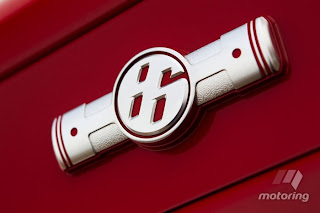
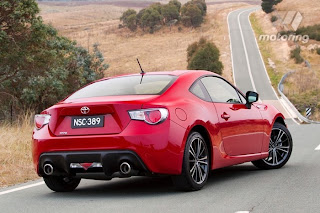
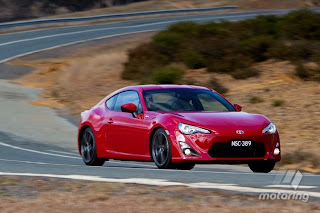
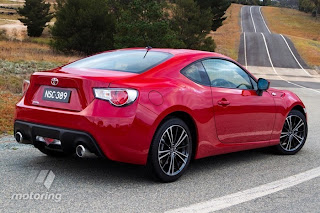


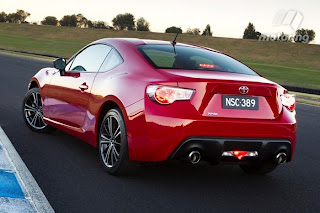















This car looks so stunning and stylish,Fully loaded with killing looks.
ReplyDelete